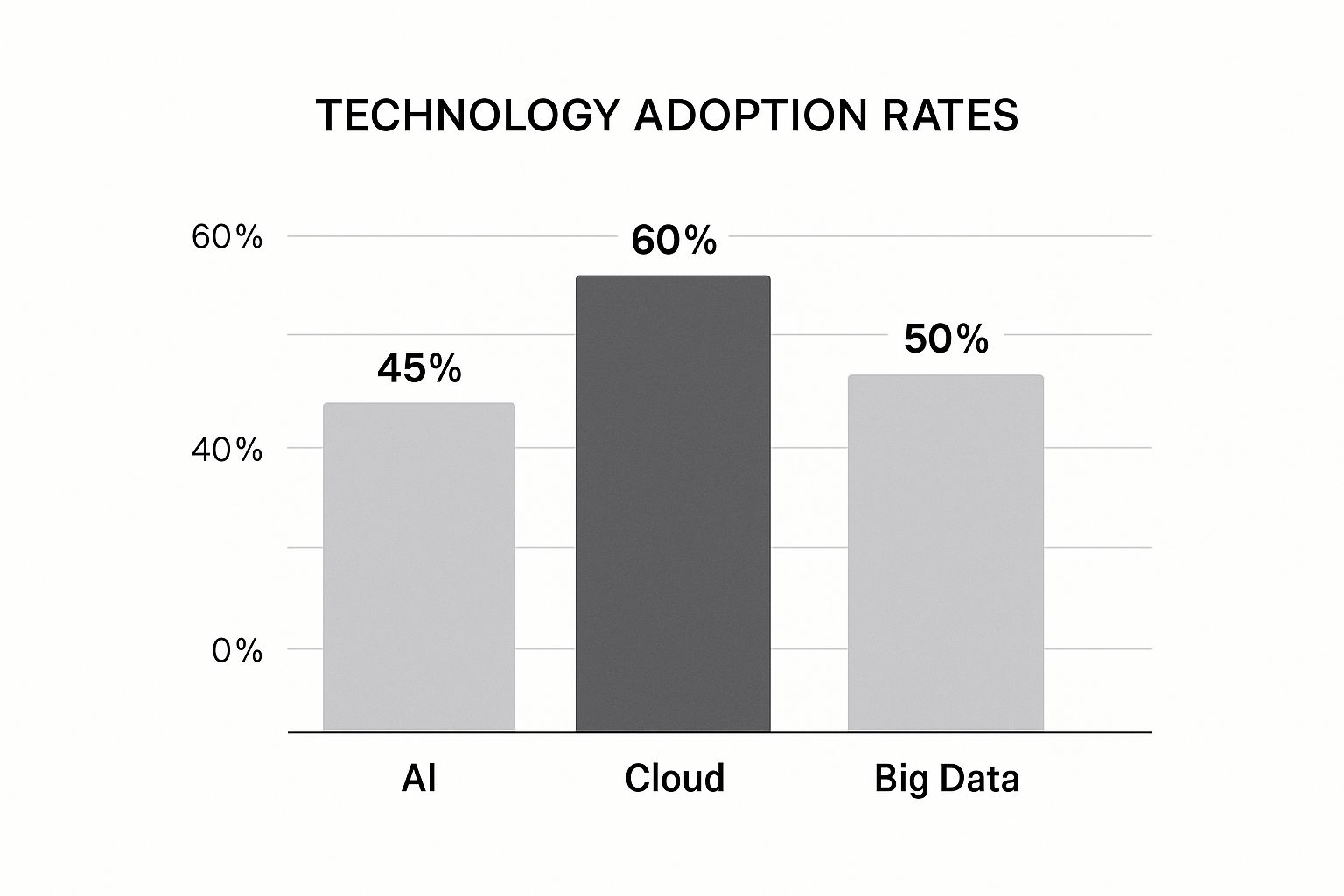
Digital Marketing Transformation in the UK: Your Essential Guide
Understanding The Digital Marketing Transformation

The UK's digital marketing scene has dramatically changed, reshaping how businesses connect with their customers. This digital marketing transformation goes beyond simply using new technologies. It's a complete overhaul of the marketing approach, moving toward a more dynamic, data-driven, and customer-focused model. This shift is fueled by both technological progress and the constantly evolving desires of consumers. As a result, even established UK companies are revisiting their strategies to stay ahead of the curve.
The Drivers of Change
A key catalyst for this transformation is the rapid advancement of technology. The rise of artificial intelligence (AI), machine learning, and big data analytics gives businesses powerful new tools to understand and engage their audiences. Artificial Intelligence powered personalization, for example, allows businesses to tailor their messages and offers to individual customers, leading to higher engagement and conversion rates. The widespread use of mobile devices has also made it vital for businesses to optimize their digital presence for a mobile-first world.
Another significant driver is the change in consumer behavior. Today's consumers are digitally savvy and expect smooth, personalized experiences across all channels. They're also more likely to research products and services online before buying, making a strong online presence essential for businesses. This means moving beyond traditional marketing tactics and embracing a more holistic, digital-first approach.
The history of digital marketing transformation in the UK reveals significant changes over the past five years. The COVID-19 pandemic significantly sped up digital adoption, pushing businesses to invest heavily in online channels and remote experiences. This shift has made digital marketing more dynamic, data-driven, and customer-centric than ever. Explore this topic further here.
Adapting to the New Reality
Successfully navigating this digital marketing transformation requires a strategic change in mindset. Businesses need to move away from isolated approaches and adopt a more integrated, omnichannel strategy. This means marketing, sales, and customer service teams must work together seamlessly to deliver a consistent brand experience across all touchpoints. It also requires a willingness to try new technologies and adapt to the constantly evolving digital world. Ultimately, businesses that embrace this transformation will be best placed to connect with their customers, drive growth, and succeed in the digital age.
Setting Strategic Priorities That Actually Drive Results

UK businesses are realizing that digital marketing is about more than just the newest tools. It's about using those tools to achieve a clear vision. This begins with setting strategic priorities that truly propel your business forward. The most successful UK businesses in the digital space understand that focusing on what truly matters is paramount.
This means moving beyond superficial metrics like likes and shares. Instead, they prioritize impactful outcomes like increased revenue, sustainable brand growth, and strong customer relationships. Building a business that lasts requires a focus on the fundamentals.
Prioritizing for Profitability and Growth
Top-performing companies carefully evaluate which digital marketing initiatives will deliver the biggest impact on their bottom line. They use data analysis to identify the channels generating the most conversions. Then, they concentrate resources on optimizing those channels for maximum ROI.
They also understand the value of building brand loyalty and repeat business. Recognizing that keeping existing customers is often more efficient than acquiring new ones, they prioritize initiatives that foster these relationships. Recent data highlights this trend: in 2025, 54% of UK businesses prioritized increasing sales revenue, while 42% focused on increasing brand awareness and customer engagement. For a deeper dive into these trends, see: UK Digital Marketing Statistics.
Frameworks for Measuring Real Success
Setting these strategic priorities goes hand-in-hand with choosing the right frameworks for measuring success. High-performing organizations go beyond surface-level metrics. They dive into data that reveals the true impact of their digital marketing efforts.
They track key performance indicators (KPIs) such as customer lifetime value, return on ad spend (ROAS), and customer churn rate. This data-driven approach enables them to identify areas for improvement and make informed decisions about resource allocation. For further insights, read: How to Master Digital Marketing for B2B.
Strategic Decisions for High Performance
Simply tracking metrics isn't enough. Successful businesses use data to inform strategic decisions that differentiate them from competitors. This might mean investing in new technologies, restructuring marketing teams, or completely overhauling their approach to customer engagement.
Guided by data and a clear understanding of their priorities, these strategic decisions enable businesses to maximize their return on digital investments and achieve sustainable growth. This proactive approach to digital marketing transformation is essential for remaining competitive in the dynamic UK market.
Building Omnichannel Marketing That Actually Works
Single-channel marketing is a thing of the past. UK businesses thriving in today's competitive environment know that omnichannel experiences are essential. This section reveals practical steps to create truly integrated marketing strategies that connect with customers at every touchpoint.
Integrating Your Channels for a Unified Experience
Effective omnichannel strategies begin with understanding your customer's journey. Map out every potential brand interaction, from initial discovery to post-purchase engagement. This helps identify key touchpoints and opportunities for a consistent brand experience.
For example, a customer might find your brand through a social media ad, visit your website, then purchase in-store. Each interaction should feel seamless, reinforcing your message and values. This integration requires collaboration between marketing, sales, and customer service.
Maintaining Brand Consistency Across Platforms
While consistency is vital, tailoring content to each platform is equally important. Think of your brand as having a consistent core personality, with different expressions depending on the context. Your tone on Twitter might be less formal than on LinkedIn, yet the underlying brand message stays consistent. This nuanced approach requires understanding each platform's audience.
Visualizing Digital Transformation
The following infographic shows adoption rates of technologies driving digital marketing transformation, including AI, cloud computing, and big data:

Cloud computing leads with a 60% adoption rate, followed by big data at 50% and AI at 45%. While these technologies are growing, there's still room for expansion, particularly in AI.
Creating Customer Journeys That Drive Engagement
Omnichannel marketing is about more than just being on multiple channels. It's about crafting meaningful journeys that foster engagement and loyalty. This means understanding customer preferences and using data to personalize interactions. For instance, if a customer abandons an online cart, a timely email or personalized offer could encourage them to complete the purchase.
Omnichannel marketing is crucial for customer retention. Companies using these strategies see 90% higher customer retention rates than single-channel approaches. Find more statistics here.
To better understand the performance differences, let's compare single-channel and omnichannel approaches across key metrics:
Single-Channel vs Omnichannel Marketing Performance Comparison
| Marketing Approach | Customer Retention Rate | Engagement Level | ROI | Implementation Complexity |
|---|---|---|---|---|
| Single-Channel | Lower (e.g., 10%) | Lower | Lower | Lower |
| Omnichannel | Higher (e.g., 90% higher) | Higher | Higher | Higher |
This table highlights the significant advantages of omnichannel marketing in terms of customer retention, engagement, and ROI, although it does come with increased implementation complexity. The investment in overcoming this complexity is well worth the rewards.
Why Some Omnichannel Strategies Fail
Omnichannel success requires more than just being present on every platform. Some strategies fail due to a lack of cohesive vision and clear objectives. Using every channel without understanding its contribution to the customer journey wastes budget and minimizes impact.
Also, failing to invest in the right technology can hinder integration and personalization. A robust CRM system and data analytics are essential for tracking customer interactions.
Finally, poor internal communication can derail plans. Ensuring all teams, from marketing and sales to customer service, work towards a shared vision is crucial for a seamless customer experience. This allows UK businesses to navigate digital marketing transformation and reach its full potential.
Leveraging Technology For Real Competitive Advantage
Technology sits at the heart of any successful digital marketing strategy. But not every new platform is worth the investment. UK businesses need to carefully consider which technologies offer a true competitive edge. This means looking beyond the hype and focusing on practical tools that deliver tangible results.
Identifying Technologies That Deliver Results
For UK businesses, two areas are especially promising: AI-powered personalisation and video marketing. AI offers the ability to analyze customer data and create truly bespoke experiences, building stronger engagement and loyalty. This might involve personalized product recommendations, targeted email campaigns, or dynamic website content.
Video marketing presents a powerful opportunity to connect with audiences in a deeper way. From short, engaging social media clips to detailed product demos, video can capture attention and build stronger relationships.
However, adopting new technologies should be a strategic decision, not a reaction to the latest trend. The UK digital marketing landscape is constantly shifting, requiring a thoughtful approach to technology investments. For example, 42% of UK marketers anticipate digital video as a key strategy, with the overall digital marketing market expected to reach $472.5 billion by 2025. More detailed statistics can be found here: UK Digital Marketing Report 2025.
Evaluating New Tools and Platforms
Choosing the right technologies requires a careful evaluation process. Consider these key questions:
- Does this technology align with our overall marketing strategy? New tools should enhance existing objectives, not add complexity.
- What specific business problem does this technology solve? Focus on technologies that address clear challenges, such as increasing customer retention or improving workflows.
- Can our team effectively use this technology? Successful implementation depends on adequate training and support.
- Does this technology integrate seamlessly with our current systems? Smooth data flow is critical for maximizing impact.
- What is the potential return on investment (ROI)? Carefully weigh the potential benefits against the implementation cost.
Building a Technology Stack for Long-Term Growth
Creating a technology stack that supports sustainable growth requires a balanced approach. Don't chase every fleeting trend; instead, build a strong foundation. This might include:
- A robust CRM system: This is crucial for managing customer relationships and data. Salesforce is a popular choice for many businesses.
- A comprehensive analytics platform: This allows you to track key performance indicators (KPIs) and measure campaign success. Google Analytics is a widely used option.
- Marketing automation tools: These tools streamline repetitive tasks and boost efficiency. HubSpot is a common platform for marketing automation.
- Content management systems (CMS): A CMS helps manage website content and optimize for search engines. WordPress is a popular and versatile CMS.
By carefully evaluating and implementing technologies, UK businesses can elevate their digital marketing efforts, build stronger customer relationships, and achieve a lasting competitive advantage. This focused approach ensures technology investments contribute to real business growth.
Navigating Compliance While Building Customer Trust

The UK's regulatory landscape is ever-evolving, bringing new complexities for businesses. Data privacy regulations, such as GDPR, are reshaping how we collect, store, and utilize customer data. This calls for a fundamental shift in our approach to digital marketing. Rather than viewing compliance as an obstacle, innovative businesses see it as a golden opportunity to cultivate trust with their valued customers.
Turning Compliance into a Competitive Edge
While regulations like GDPR present undeniable challenges, they also offer a unique platform to showcase your commitment to customer privacy. This transparency can set you apart in a competitive marketplace. When customers recognize that you prioritize the security of their data, they are more inclined to connect with your brand. This deeper engagement can blossom into lasting customer relationships and ultimately, drive revenue growth.
Practical Steps for Data Protection and Marketing Effectiveness
So, how can UK businesses guarantee robust data protection while maintaining impactful marketing strategies? Here are a few practical steps:
- Obtain explicit consent: Articulate clearly how you intend to use customer data and secure their explicit consent before collecting or processing any information.
- Provide transparency: Operate with an open-door policy regarding your data collection and usage practices. Ensure your privacy policy is readily accessible and easy to understand.
- Offer data control: Empower your customers with control over their own data. Enable them to access, update, and delete their information effortlessly.
- Secure data storage: Implement stringent security measures to safeguard customer data from unauthorized access and potential breaches.
Building Customer Confidence Through Transparency
Transparency is more than just a legal obligation; it's a cornerstone of customer confidence. By being upfront about how you handle data, you demonstrate respect for your customers. This nurtures trust, encouraging them to share their information and engage more deeply with your brand. For further insights, explore our article on How to Master Earned Media Value.
Strategic Approaches for Personalised Experiences
Customers crave personalized experiences, but they also hold their privacy dear. Achieving the right balance demands a strategic approach:
- Focus on value exchange: Offer tangible value in return for data. Explain how sharing their information will directly benefit them, such as through personalized recommendations or exclusive offers.
- Use data responsibly: Collect and use only the data that is essential for providing the desired service or experience. Refrain from collecting excessive or irrelevant information.
- Segment audiences strategically: Group customers based on common preferences and behaviors to deliver targeted and relevant marketing messages without infringing on individual privacy.
By adopting these strategies, businesses can successfully navigate the intricate world of compliance while simultaneously strengthening customer trust. This approach not only mitigates legal risks but also establishes your business as a responsible and dependable partner in the eyes of your customers. This dual benefit makes compliance a critical component of successful digital marketing in the UK.
Measuring Success And Optimising For Growth
Transforming your digital marketing isn't simply about making changes; it's about charting a clear course toward improvement. The most triumphant transformations hinge on robust measurement frameworks. These frameworks provide crucial insights into which strategies are truly hitting the mark and which ones need a little extra attention. This section explores the essential Key Performance Indicators (KPIs) for UK businesses, how to establish effective tracking mechanisms, and proven optimization strategies for continuous, measurable growth.
Key Performance Indicators That Matter
Selecting the right KPIs is paramount to gauging the success of your digital marketing transformation. While metrics like website traffic and social media engagement offer a glimpse into performance, they don't paint the whole picture. UK businesses should prioritize KPIs that directly impact their bottom line.
-
Customer Lifetime Value (CLTV): This crucial metric reveals the total revenue generated by a customer throughout their journey with your business. A rising CLTV signifies that your marketing efforts are effectively attracting and, importantly, retaining high-value customers.
-
Return on Ad Spend (ROAS): This KPI demonstrates the return you're getting for every pound invested in advertising. A healthy ROAS indicates efficient ad campaigns and precise audience targeting. Are you reaching the right people with the right message? ROAS can tell you.
-
Conversion Rate: This metric measures the percentage of website visitors or leads who take a desired action, such as making a purchase or completing a contact form. Optimizing conversion rates is essential for maximizing revenue generation. Small improvements can make a big difference.
-
Customer Churn Rate: This KPI tracks the percentage of customers who discontinue using your product or service within a specific timeframe. A low churn rate is a strong indicator of customer satisfaction, loyalty, and the effectiveness of your retention strategies.
To further explore creating a powerful digital brand strategy, check out this helpful resource: How to Master Digital Brand Strategy.
Setting Up Effective Tracking Systems
After identifying your core KPIs, establishing accurate tracking systems is the next critical step. Leverage powerful analytics platforms like Google Analytics to monitor website traffic, user behavior, and conversion rates. Implementing conversion tracking on your advertising campaigns is crucial for measuring ROAS and pinpointing high-performing channels. Consider incorporating CRM systems to track customer interactions and calculate CLTV. This data-driven methodology empowers you to make informed decisions based on concrete evidence, not guesswork.
Methodologies for Continuous Optimisation
The digital marketing landscape is ever-changing. Therefore, ongoing optimization is essential for maintaining peak performance. A/B testing is a powerful technique to compare different variations of your website, ads, or email campaigns. By analyzing the results, you can identify the most effective versions and refine your approach. Data analysis also plays a vital role in uncovering trends and patterns in customer behavior, allowing you to fine-tune your targeting and messaging for maximum impact. Regularly reviewing your KPIs and adjusting your strategies based on the data you gather is crucial for sustained success. This iterative process ensures your digital marketing transformation remains aligned with your evolving business objectives.
Measuring Beyond Traditional Metrics: Creating Feedback Loops
Successful UK companies recognize that true success transcends numerical KPIs. They actively solicit customer feedback through surveys, online reviews, and social media monitoring. This qualitative data adds valuable context, helping you understand the why behind the numbers. Establishing effective feedback loops is essential for uncovering areas for improvement and enriching the customer experience. This comprehensive approach to measurement ensures your digital marketing transformation delivers not only measurable results, but also fosters meaningful customer relationships, nurturing long-term loyalty and advocacy.
Before we delve deeper into optimization strategies, let's examine a table highlighting the core KPIs that UK businesses should be tracking as part of their digital marketing transformation.
Essential Digital Marketing Transformation KPIs
Key performance indicators and metrics that UK businesses should track to measure the success of their digital marketing transformation
| KPI Category | Primary Metrics | Measurement Frequency | Target Benchmarks | Business Impact |
|---|---|---|---|---|
| Customer Acquisition | Customer Acquisition Cost (CAC), Conversion Rate | Monthly | Industry average or lower CAC, Increasing conversion rate | Improved marketing ROI, Increased customer base |
| Customer Retention | Customer Churn Rate, Customer Lifetime Value (CLTV) | Quarterly | Decreasing churn rate, Increasing CLTV | Reduced customer acquisition costs, Increased profitability |
| Revenue Generation | Return on Ad Spend (ROAS), Average Order Value (AOV) | Monthly | Increasing ROAS, Increasing AOV | Improved profitability, Increased revenue |
| Website Performance | Website Traffic, Bounce Rate, Time on Site | Weekly | Increasing traffic, Decreasing bounce rate, Increasing time on site | Improved user engagement, Increased conversions |
| Brand Awareness | Social Media Engagement, Brand Mentions | Weekly | Increasing engagement, Positive brand sentiment | Improved brand reputation, Increased customer loyalty |
This table provides a starting point for tracking your progress. Remember to tailor these KPIs to your specific business goals and industry benchmarks. By focusing on these elements, your UK business can truly harness the power of digital marketing transformation to achieve sustainable growth and solidify its position within the competitive market.
Your Digital Marketing Transformation Action Plan
This section offers a practical guide to transforming your digital marketing presence in the UK. We'll cover essential first steps, prioritization strategies, and key milestones that indicate genuine progress. This guide also includes proven methods for managing the changes, fostering internal support, and establishing realistic timelines.
Phase 1: Assessment and Goal Setting
Before embarking on a digital marketing transformation, it’s essential to understand your current situation. This involves a thorough review of your existing marketing efforts, your current technology, and the customer journey.
-
Audit Existing Marketing Activities: Analyze the effectiveness of your current strategies across different channels. Are your social media campaigns attracting potential customers? Is your website designed for conversions? This assessment helps pinpoint areas for improvement and shapes your future strategy.
-
Analyze Your Technology Stack: Assess the tools and platforms you're using. Do they integrate seamlessly? Do they support your marketing goals? A technology audit identifies gaps and unnecessary duplication.
-
Map the Customer Journey: Understand how customers interact with your brand at each touchpoint, from initial discovery to after they've made a purchase. This reveals opportunities to personalize and enhance the customer experience.
After assessing your present state, the next step is setting clear, measurable goals. These objectives should align with your overarching business strategy. For example, your goals might include increasing website traffic, improving conversion rates, or boosting customer retention.
Phase 2: Building Your Roadmap
Once your goals are set, it's time to create a detailed roadmap for your digital marketing transformation. This includes prioritizing projects, allocating resources, and setting timelines.
-
Prioritize Initiatives: Concentrate on the projects that will have the greatest impact on your key performance indicators (KPIs). This might involve implementing a new CRM system like Salesforce, optimizing your website for mobile devices, or starting a video marketing campaign.
-
Allocate Resources: Ensure you have the necessary resources—budget, staff, and technology—to support your initiatives. This requires thoughtful planning and cross-departmental collaboration.
-
Establish Timelines: Set achievable deadlines for each stage of your transformation. This keeps the project moving forward and ensures accountability. Consider dividing large projects into smaller, more manageable tasks.
Phase 3: Implementation and Optimization
The implementation phase involves putting your roadmap into action. This requires careful coordination and continuous monitoring.
-
Execute Your Plan: Begin implementing your prioritized initiatives, tracking progress against your set deadlines. This might include training staff on new technologies, creating fresh content, or launching new campaigns.
-
Monitor Performance: Carefully track your KPIs to measure the effectiveness of your transformation. This offers valuable insights and allows you to adapt your strategy as needed.
-
Optimize Continuously: Digital marketing is constantly evolving. Regularly review your performance, experiment with new approaches, and adjust to changing market conditions for continued success.
Building Internal Buy-In
A successful digital marketing transformation hinges on securing buy-in from everyone involved.
-
Communicate Clearly: Explain the reasons behind the transformation, emphasizing the benefits for the business and individual teams. This creates a shared understanding and generates enthusiasm.
-
Involve Key Stakeholders: Involve teams from across the organization, gathering feedback and addressing any concerns. This ensures alignment between the transformation and everyone's needs and goals.
-
Celebrate Successes: Acknowledge and celebrate accomplishments throughout the process. This maintains momentum and reinforces the value of the transformation.
By following this action plan, you can successfully navigate the challenges of digital marketing transformation, build a stronger online presence, and achieve sustainable growth in the competitive UK market. Ready to elevate your digital marketing? Connect with Blackbird Digital today to discover how we can help you reach your digital marketing goals. Transform your marketing with Blackbird Digital.




